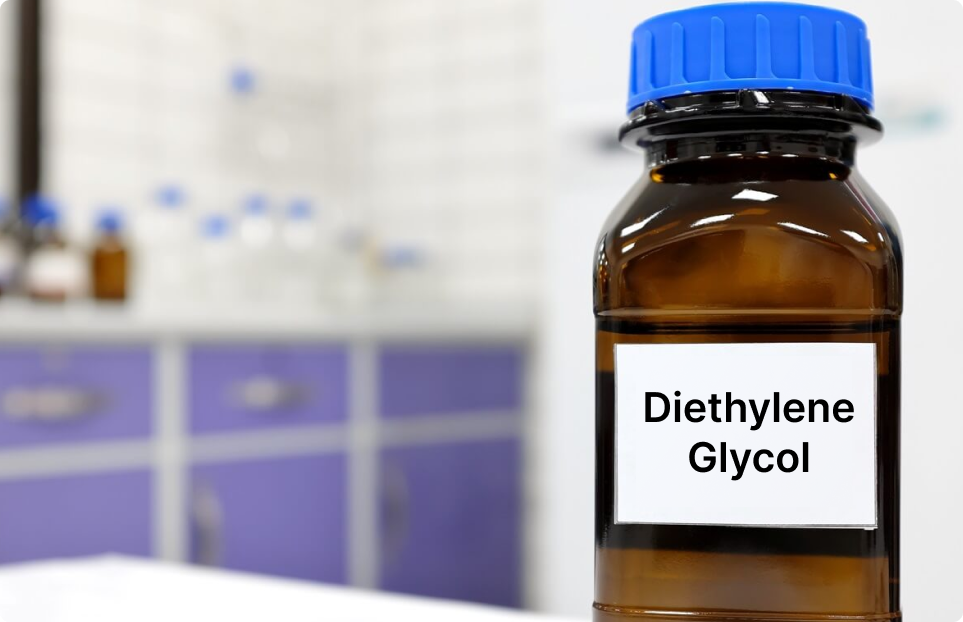
June 26, 2024
Exploring Diethylene Glycol
Diethylene glycol (DEG) is a clear, colorless, odorless, and slightly viscous liquid with a sweetish taste. It has a molecular formula of C4H10O3 and a molecular weight of 106.12 g/mol. DEG exhibits properties characteristic of both alcohols and ethers due to its ether and alcohol groups. DEG is miscible with water, ethers, lower aliphatic alcohols, aldehydes, and ketones, and is partially soluble in benzene, carbon tetrachloride, mono benzene, ortho dichlorobenzene, and toluene.
Traditional Production Method: Ethoxylation of Ethylene Glycol
The traditional method for producing DEG is the ethoxylation of ethylene glycol. In this process, ethylene glycol is reacted with ethylene oxide in the presence of a catalyst, such as sodium hydroxide or potassium hydroxide, to form DEG and higher glycols. The reaction is carried out at elevated temperatures and pressures, and the desired product is separated by distillation.
Emerging Production Method: Oxidation of Ethylene
An emerging method for producing DEG is the oxidation of ethylene. In this process, ethylene is first converted to ethylene oxide, which is then reacted with water to form ethylene glycol. DEG is then produced by the further ethoxylation of ethylene glycol. This method has the potential to be more cost-effective and environmentally friendly than the traditional method.
Traditional Applications of DEG
DEG’s versatility shines in its traditional applications across various industries:
Textile Industry
- Conditioning Agent: DEG acts as a conditioning agent for fabrics like wool, rayon, and cotton, making them softer and easier to handle during processing. (Image of Textile conditioning machine)
- Solvent for Dyes and Printing Inks: DEG’s ability to dissolve dyes and printing inks uniformly makes it valuable in textile dyeing and printing processes. (Image of Textile printing machine)
- Auxiliary Agent: DEG can be used as an auxiliary agent in textile dyeing to improve dye penetration and colorfastness.
Paper Industry
- Softening Agent: Similar to textiles, DEG acts as a softening agent for paper, improving its flexibility and reducing brittleness. (Image of Paper production line)
- Humectant: DEG’s hygroscopic nature (attracts moisture) helps maintain paper’s moisture content, preventing it from becoming dry and brittle.
Chemical Industry
- Intermediate in Polyester Resins: DEG is a crucial ingredient in the production of polyester resins used in fiberglass-reinforced plastics for applications like boat hulls, pipes, and automotive parts. (Image of Fiberglass boat)
- Dehydrating Agent: DEG can be used as a dehydrating agent in natural gas processing, removing moisture, hydrogen sulfide, and carbon dioxide to ensure safe and efficient transportation.
- Chemical Intermediate: DEG serves as a starting material for the production of various other chemicals, such as antifreeze and heat transfer fluids.
Emerging Applications of DEG
As research progresses, exciting new applications for DEG are emerging:
Dehydrating Agent for Biodiesel Production: DEG can act as a co-solvent in biodiesel production, facilitating the removal of water during the transesterification reaction that converts vegetable oils into biodiesel. (Image of Biodiesel production plant)
Ingredient in Cutting Oils: DEG can be used as a component in cutting oils, which cool and lubricate metal during machining operations.
Softening Agent in Various Products: DEG’s softening properties extend beyond textiles and paper. It can be used as a softening agent in tobacco, synthetic sponges, glues, and casein-based products.
Potential Hazards and Safety Considerations
Despite its widespread use, DEG can be toxic when ingested or absorbed through the skin. It can cause kidney and liver damage, central nervous system depression, convulsions, and coma. Ingestion of large amounts of DEG can lead to death. Exposure to DEG can occur through inhalation, ingestion, or skin contact, and it is important to follow proper safety precautions when handling DEG and to use protective clothing, gloves, and goggles.
Future Outlook for Diethylene Glycol
The global demand for DEG is expected to continue growing in the coming years, driven by its diverse applications and the increasing need for sustainable and eco-friendly solutions. As industries strive for greater efficiency and innovation, the versatility of DEG will undoubtedly continue to drive its importance in the future. However, it is crucial to address the potential health concerns associated with DEG and ensure its safe handling and use.
In conclusion, diethylene glycol is a versatile and widely used chemical compound with a diverse range of applications. While the traditional ethoxylation of ethylene glycol remains the dominant production method, emerging methods like the oxidation of ethylene show promise for more sustainable and cost-effective production. As the demand for DEG continues to grow, it will be essential to balance its benefits with the potential risks and ensure its safe use in various industries.


